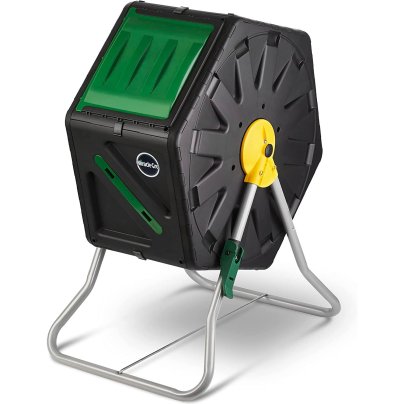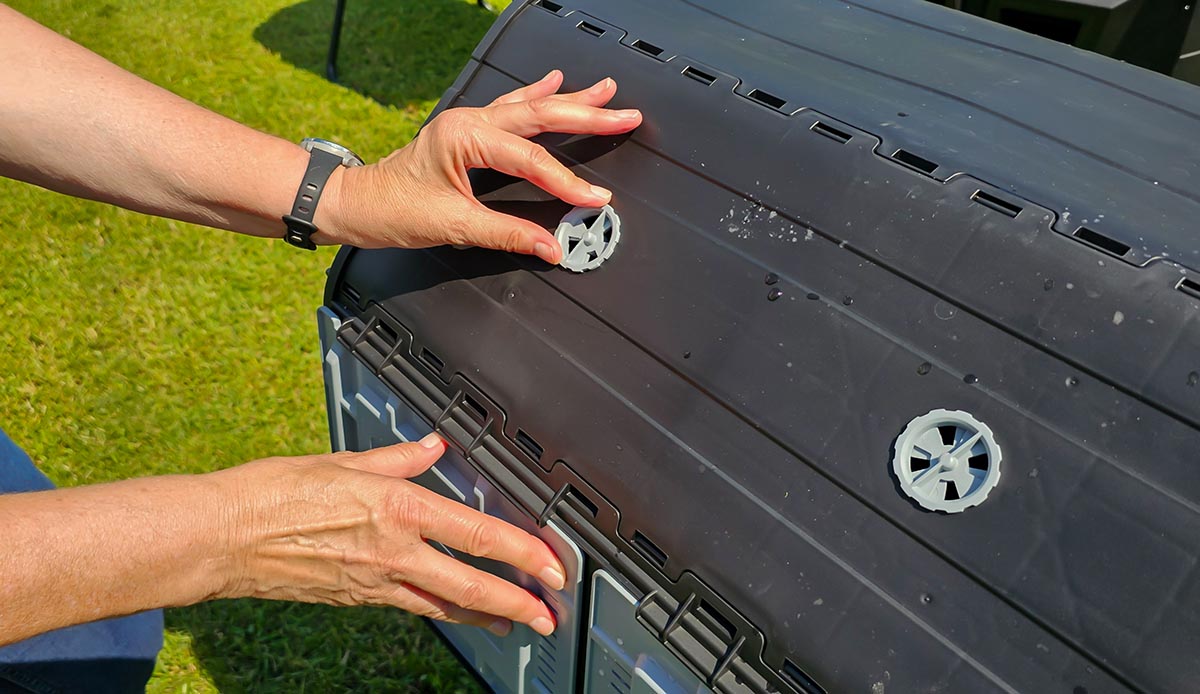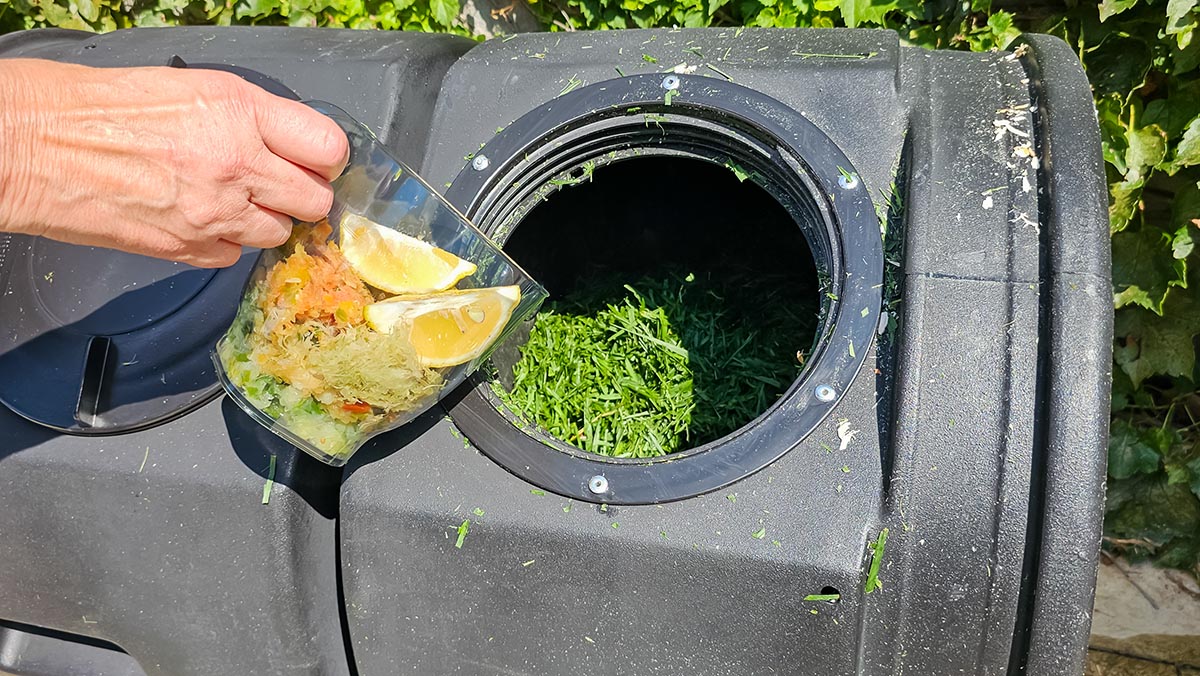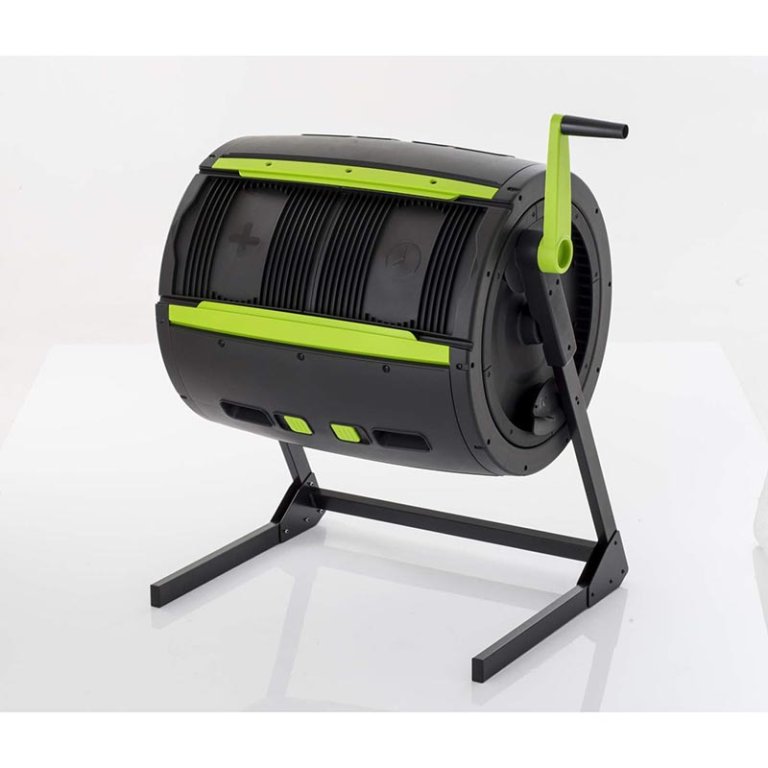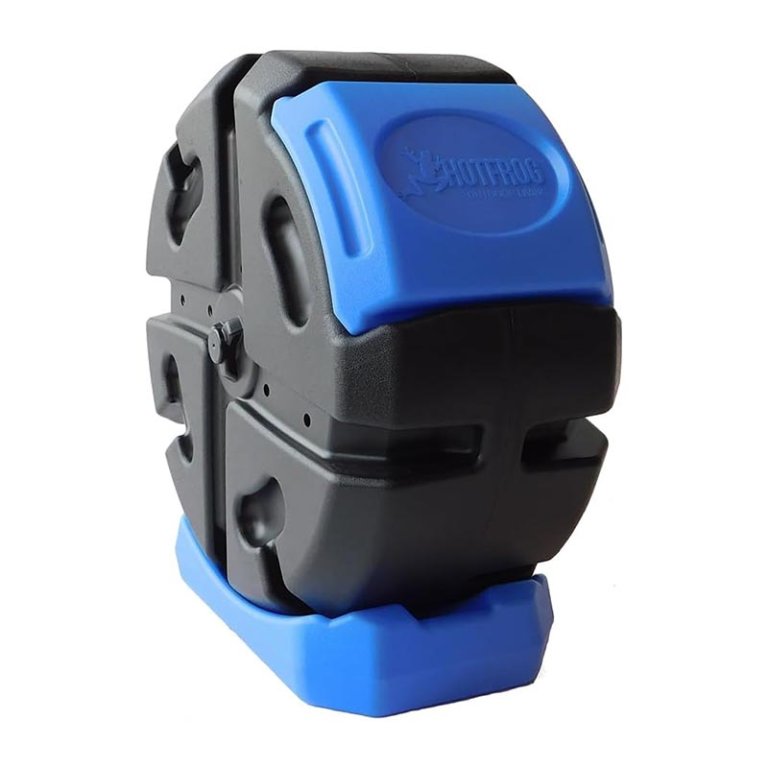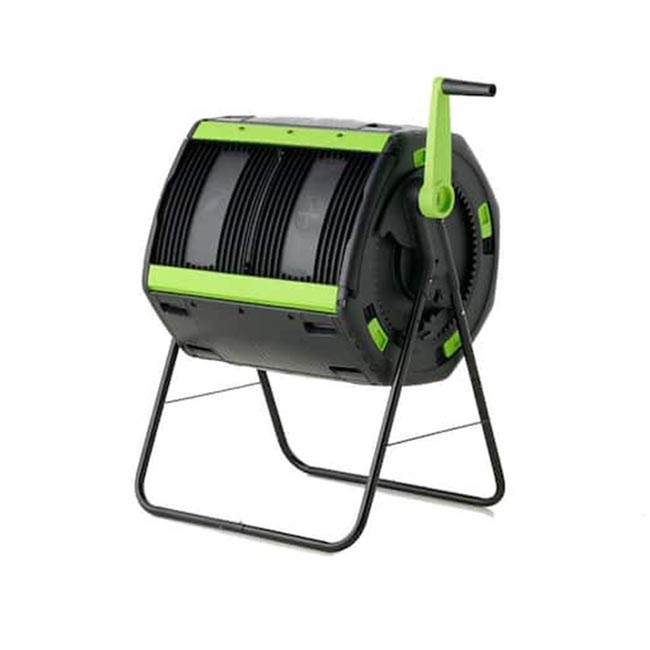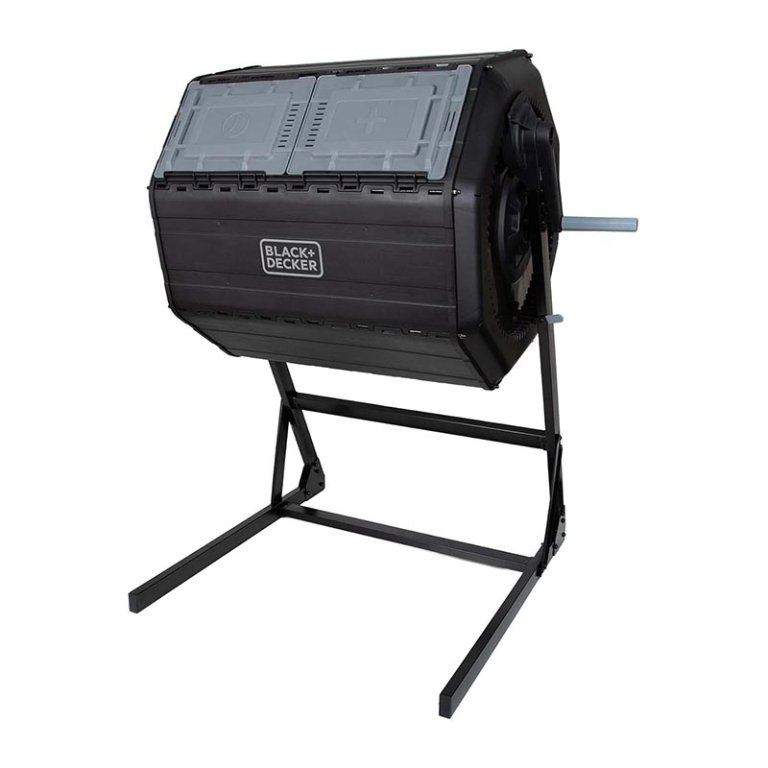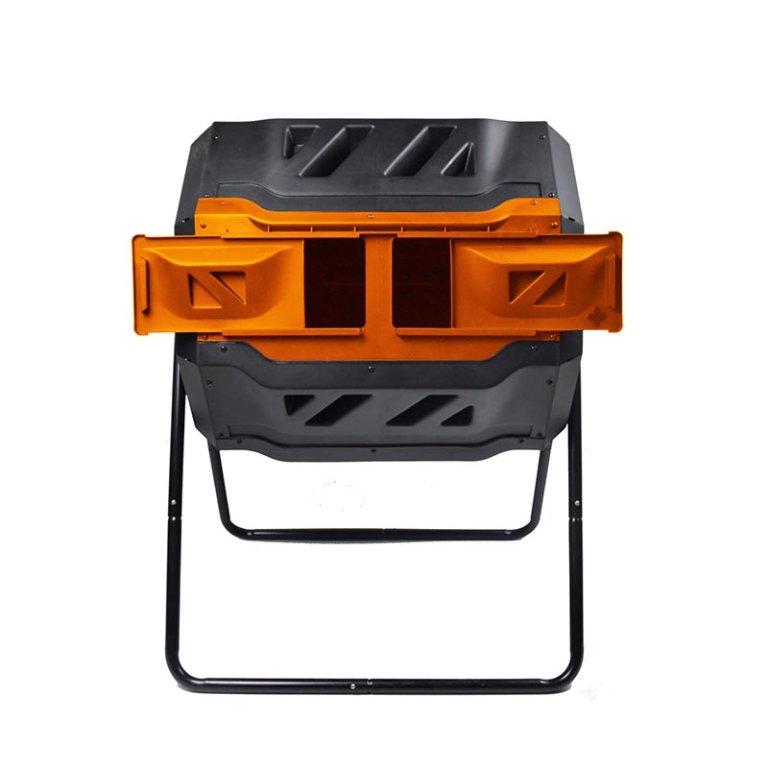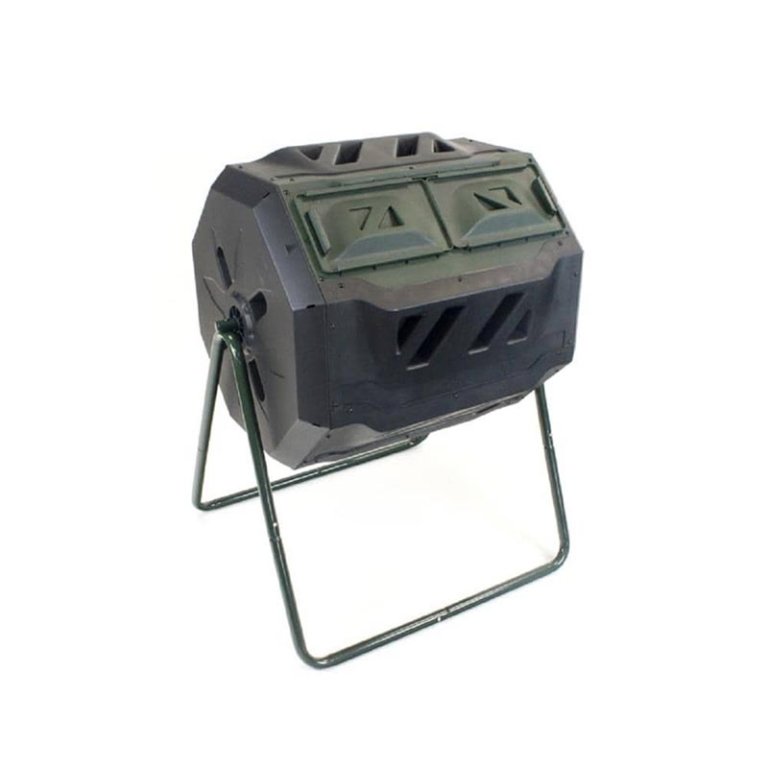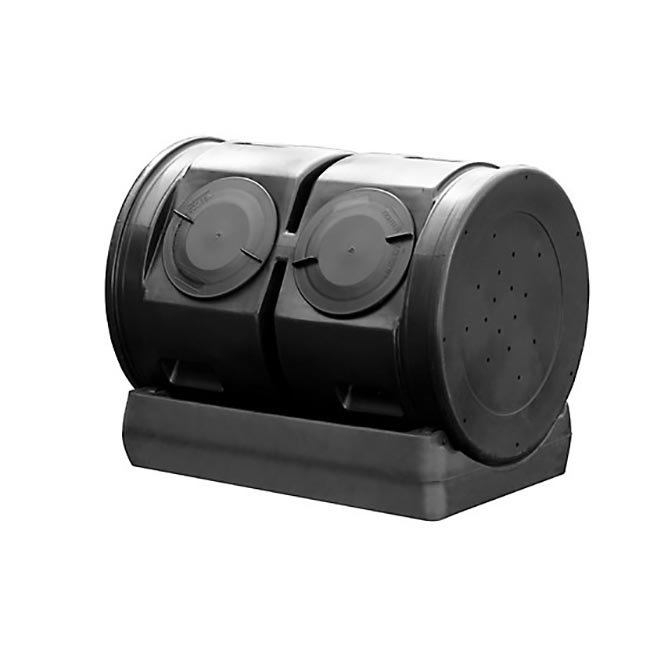
We may earn revenue from the products available on this page and participate in affiliate programs. Learn More ›
Composting has numerous benefits, and having a compost tumbler makes the process even easier. In addition to recycling kitchen, lawn, and garden waste into a helpful soil amendment, composting helps keep significant amounts of organic waste out of landfills. As lawn care and gardening enthusiasts, we wanted to find out just how easy these contraptions made the task, so we tested several. For 8 weeks, we filled and turned tumblers, yielding over 100 pounds of plant-enriching compost.
After testing, we selected the RSI Maze 65-Gallon Compost Tumbler as our favorite due to its overall ease of use and smart design, but it’s not the only great option. Ahead, learn more about how these products fared in testing, and discover which considerations are worth bearing in mind when you’re shopping for the best compost tumbler.
- BEST OVERALL: RSI Maze 65-Gallon Compost Tumbler
↓ Jump to Review - BEST BANG FOR THE BUCK: FCMP Half-Size Rolling Composter
↓ Jump to Review - BEST SMALL: Miracle-Gro Tumbling Composter
↓ Jump to Review - BEST CONTINUAL COMPOST: RSI Maze 48-Gallon Two-Compartment Compost Tumbler
↓ Jump to Review - BEST TURNING GEAR: Black+Decker 40-Gallon Dual Chamber Compost Tumbler
↓ Jump to Review - BEST RODENT RESISTANCE: Genesis 42-Gallon Dual Compost Tumbler
↓ Jump to Review - BEST DUAL CHAMBERS: Exaco 43-Gallon Recycled Plastic Compost Tumbler
↓ Jump to Review - BEST COMPOST TEA: Good Ideas 50-Gallon Compost Wizard Tumbler Kit
↓ Jump to Review
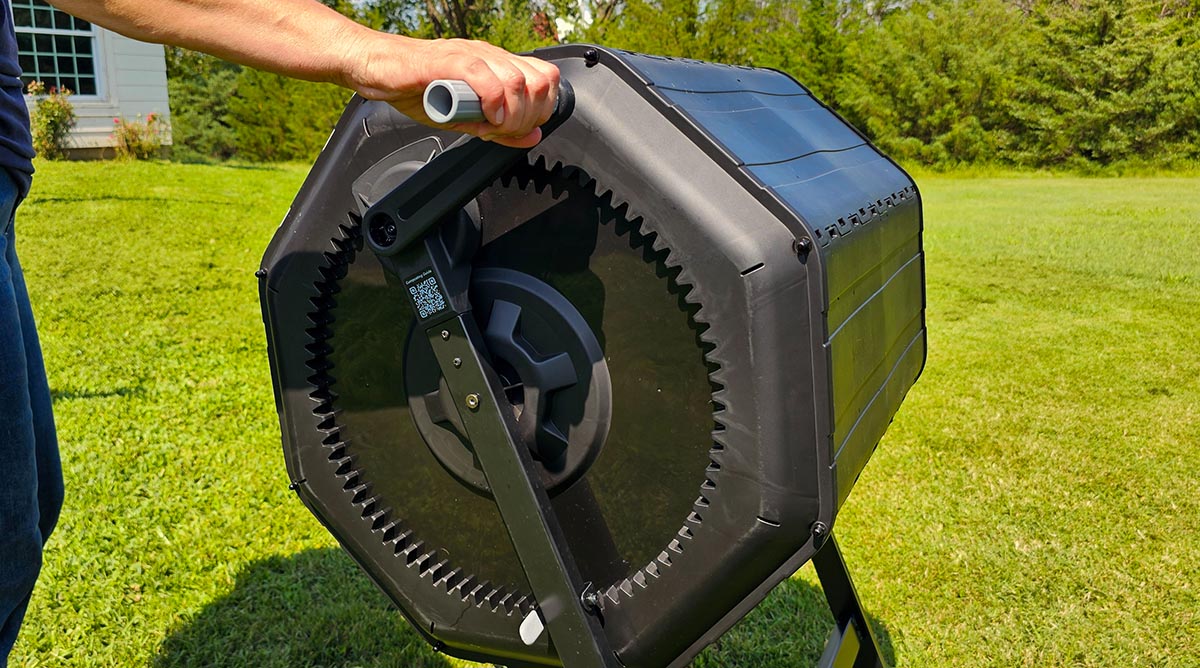
Compost Tumblers Comparison
| Product | Capacity | Dimensions | Weight |
| RSI Maze 65-Gallon Compost Tumbler | 65 gallons | 44.5 inches tall by 41.3 inches wide by 30 inches deep | 54 pounds |
| FCMP Half-Size Rolling Composter | 19 gallons | 24 inches tall by 12 inches wide by 24 inches deep | 15 pounds |
| Miracle-Gro Tumbling Composter | 18.5 gallons | 29.5 inches tall by 17 inches wide by 23.5 inches deep | 10.6 pounds |
| RSI Maze 48-Gallon Two-Compartment Compost Tumbler | 48 gallons | 43 inches tall by 36 inches wide by 25 inches deep | 26 pounds |
| Black+Decker 40-Gallon Dual Chamber Compost Tumbler | 40 gallons | 37.9 inches tall by 29.4 inches wide by 29.1 inches deep | 33 pounds |
| Genesis 42-Gallon Dual Compost Tumbler | 42 gallons | 37 inches tall by 28.5 inches wide by 26 inches deep | 24 pounds |
| Exaco 43-Gallon Recycled Plastic Compost Tumbler | 43 gallons | 37 inches tall by 28 inches wide by 26 inches deep | 28 pounds |
| Good Ideas 50-Gallon Compost Wizard Tumbler Kit | 50 gallons | 25 inches tall by 30 inches wide by 22 inches deep | 33 pounds |
Our Top Picks
We tested each of these composters, from assembly to everyday use, to determine the best picks for both small and large home gardens.
Best Overall
Photo: AmazonWhat We Like
- Easy to turn even when full
- Ample size suits high-volume use
- Dual chambers
What We Don’t Like
- Heavyweight makes it difficult to move
- May take 2 hands to crank
Specs
- Capacity 65 gallons
- Dimensions 44.5 inches tall by 41.3 inches wide by 30 inches deep
- Weight 54 pounds
Our Ratings
| Assembly | 5/5 | Ease of Use | 5/5 | Build Quality | 4.5/5 | Value | 5/5 |
The 65-gallon RSI Maze Compost Tumbler makes controlling the bin simple and smooth, even when fully loaded, with a geared handle and ratchet lock. The bin features air vents on all sides and large sliding covers that simplify loading and unloading. The dual-chamber design facilitates a consistent flow of garden waste in and compost out. This is a suitable size for medium to large gardens and landscapes.
The 65-gallon (8.69-cubic-foot) bin is made of UV-protected high-impact plastic. The frame is made of rust- and corrosion-resistant zinc-coated steel. It offers 15 inches of ground clearance for unloading compost via a cart.
We loved the size of this composter as well as its hand crank, which made it easy to turn even when the composter was full. We filled it with organic vegetable and fruit scraps, dry leaves, and dry grass.
This tumbler’s crank was a unique feature. Rather than having to roll the barrel, the crank allowed us to turn the bin with ease and “stop” it in a position where it was easiest to empty it. It is heavy, though, so users should be mindful of where to place it. Once it’s full, it’s difficult to move.
What our tester says: “I found this product to be high quality. It’s very durable, thanks in part to its rust-resistant zinc coating. Additionally, it’s relatively simple to assemble, and it’s easy to use.”—Jenn Ryan, Product Reviews tester and writer
Read our full review: RSI Maze Two-Stage Compost Tumbler
Get the RSI compost tumbler at Amazon, Lowe’s, Tractor Supply Co., or The Home Depot.
Best Bang for the Buck
Photo: AmazonWhat We Like
- Very easy to assemble
- Compact size fits virtually anywhere
- Lightweight for easy transport
What We Don’t Like
- Bin difficult to turn
- Requires more turning
- Needs to be picked up to be emptied
Specs
- Capacity 19 gallons
- Dimensions 24 inches tall by 12 inches wide by 24 inches deep
- Weight 15 pounds
Our Ratings
| Assembly | 5/5 | Ease of Use | 5/5 | Build Quality | 4.5/5 | Value | 5/5 |
The FCMP Half-Size Rolling Composter is a compact, affordable pick ideal for one or two people who don’t generate much compostable waste. The ground-rolling design gives this unit a low profile that easily tucks away in small spaces, such as a balcony, patio, or garage. Built-in ergonomic handholds help make rolling less awkward. Aeration holes and deep fins break up clumps inside the chamber to maximize oxygen penetration.
The 19-gallon (2.5-cubic-foot) bin is made of recycled UV-inhibited BPA-free polyethylene. To speed decomposition, the manufacturer recommends turning the bin about twice a day.
The assembly of this product couldn’t have been easier. The composter came almost completely assembled—all we needed to do was place it on the stand and slide the door on. Although we loved the size and portability of this composter, it was too small for a large garden and would make a better option for urban composters, those with a small garden, or those who want to use compost for indoor or potted plants.
During testing, the composter needed to be turned frequently; for balance, using two hands was best. We also found it challenging to turn because it is not attached to the base; it merely sits on the stand, and both the stand and the composter can slide off balance. We found that the turning process was best done slowly, but people with mobility challenges may find this composter difficult to use, as it’s low to the ground and needs to be turned by hand.
We also found that the door was a bit tight and tricky to open and close when filling with compost and emptying. For emptying, the composter needs to be lifted, which can also be a challenge when it is full and heavy.
Overall, this composter makes a great option for those with smaller gardens, those who want zero-fuss assembly, or those who want a small but sturdy composter they can easily store out of sight.
Get the FCMP half-size compost tumbler at Amazon or Wayfair.
Best Small
Photo: AmazonWhat We Like
- Small size; easy to turn and rotate
- Simple assembly takes less than 1 hour
- Compact for easy transport and placement
What We Don’t Like
- Tight door; hard to fill with 1 hand
- No printed instruction booklet
Specs
- Capacity 18.5 gallons
- Dimensions 29.5 inches tall by 17 inches wide by 23.5 inches deep
- Weight 10.6 pounds
Our Ratings
| Assembly | 5/5 | Ease of Use | 5/5 | Build Quality | 4.5/5 | Value | 5/5 |
The Miracle-Gro Tumbling Composter provides a convenient place to recycle veggie scraps and houseplant debris while fitting easily into a small space. The hexagonal 18.5-gallon (2.47-cubic-foot) chamber features aeration holes and mixing bars for better oxygen infusion. Tight-locking slide doors keep out pests. For easy loading and unloading, toppers on the frame lock the bin rotation.
The UV-protected plastic chamber is built to withstand exposure to weather. The powder-coated stainless steel frame makes it easy not only to load, unload, and rotate the bin, but also to sweep or blow out debris from underneath. The composter requires some assembly, but that is made easy with step-by-step directions via a QR code. The package includes a pair of water-resistant, no-slip grip garden gloves.
Assembly for this composter was simple thanks to the included QR code that walked us through each step with 3D images—no app download required. We loved that this composter was easier to turn in a more compact size—perfect for one- or two-person households with small gardens or for urban gardeners. Since it is a smaller size, we found that the bin remained easy to turn even as it filled with compost. Its small size also makes it convenient for placing in a more conspicuous location as opposed to large dual-bin composters.
On the downside, we found that the door on this compost bin was a bit too tight and difficult to open with one hand. The frame of the composter is narrow, and combined with the fact that the composter is just inches from the ground means only a shallow dish or trough will fit under the frame to empty the compost. (In testing, we used an old sled for emptying and transporting the compost out of this tumbler.)
Get the Miracle-Gro compost tumbler at Amazon or The Home Depot.
Best Continuous Compost
RSI Maze 48-Gallon Two-Compartment Compost Tumbler
Buy at The Home Depot Buy at Northern Tool + Equipment Buy at WalmartWhat We Like
- Smooth, gear-driven tumbling
- Dual-chamber design
- UV-protected barrel
What We Don’t Like
- Assembly can be tricky
Specs
- Capacity 48 gallons
- Dimensions 43 inches tall by 36 inches wide by 25 inches deep
- Weight 26 pounds
Our Ratings
| Assembly | 3.5/5 | Ease of Use | 4.8/5 | Build Quality | 4/5 | Value | 4.3/5 |
The RSI Maze 48‑gallon compost tumbler can be used for uninterrupted composting thanks to its dual-chamber design. The geared crank handle made turning easy, even when loaded. We liked its UV-protected barrel and galvanized steel frame, which are made especially for outdoor use.
Assembly posed a small challenge as some of the components were pretty tight and had to be forced into place. But once built, it worked smoothly and reliably. The sliding doors and ratchet lock held the drum in position, allowing easy collection of finished compost into a cart or bucket placed underneath.
The only drawback we noted was the assembly process, but that’s a one‑time obstacle worth dealing with as the daily ease and performance thereafter make up for it. Overall, the Maze tumbler delivers high usability with long-term value and minimal maintenance.
Get the Maze compost tumbler at The Home Depot, Northern Tool + Equipment, or Walmart.
Best Turning Gear
Black+Decker 40-Gallon Dual Chamber Compost Tumbler
Buy at Amazon Buy at Ace Hardware Buy at WalmartWhat We Like
- Easy turning operation
- Dual composting chambers
- Secure sliding compost doors
What We Don’t Like
- Harder to turn with a full load
Specs
- Capacity 40 gallons
- Dimensions 37.9 inches tall by 29.4 inches wide by 29.1 inches deep
- Weight 33 pounds
Our Ratings
| Assembly | 4/5 | Ease of Use | 4.3/5 | Build Quality | 4.3/5 | Value | 4.2/5 |
The Black+Decker impressed us with its quality materials and design. The oversize gear handle made turning the compost barrel feel effortless with small to medium-size loads, and we liked the dual-chamber configuration that allowed us to continue adding new materials without pausing composting.
The elevated design not only made loading and unloading easier but also helped to keep pests at bay. The sliding doors are intuitive to open and close, and the overall build is solid. The design is really convenient, but it might have been a good idea to make the doors a little larger. We ran into some issues with dumping the finished compost out by rolling the barrel to the bottom, and we had to scoop most of it out, which was time-consuming.
Plus, the weight is noticeable when the chambers are filled—it took more effort to turn them when they were loaded and after a heavy rain that let water into the barrel. But that’s really a minor issue; the ease of assembly, continuous composting potential, and quality build make it an excellent midsize option for gardeners who want reliability with minimal fuss.
Get the Black + Decker compost tumbler at Amazon, Ace Hardware, or Walmart.
Best Rodent Resistance
Genesis 42-Gallon Dual Compost Tumbler
Buy at Amazon Buy at Tractor Supply Co. Buy at The Home DepotWhat We Like
- Snug-fitting doors keep rodents out
- Built-in mixing rods
- Ample vent ports
What We Don’t Like
- Slightly narrow access doors
Specs
- Capacity 42 gallons
- Dimensions 37 inches tall by 28.5 inches wide by 26 inches deep
- Weight 24 pounds
Our Ratings
| Assembly | 4.5/5 | Ease of Use | 4.5/5 | Build Quality | 4.3/5 | Value | 4.3/5 |
We found the Genesis compost tumbler to be robust yet compact enough for backyard composting. We’re sold on its “rodent‑proof” design, too. Its secure sliding doors and solid construction succeeded in keeping the little critters out during our testing. We also liked the internal mixing rods and multiple ventilation points—the compost in this tumbler seemed to biodegrade more quickly than in the others we tested.
Despite its sturdy materials and tight assembly, we found it lightweight enough to rotate comfortably. Its design takes up only a small footprint but still offers substantial capacity. The UV-resistant barrel and powder-coated frame are built for long-term outdoor exposure.
On the downside, we think the doors could be wider, which would making loading and removing compost slightly less cumbersome. Still, for its build quality, ease of use, and continuous composting capability, we think the Genesis tumbler is a solid value.
Get the Genesis compost tumbler at Amazon, Tractor Supply Co., or The Home Depot.
Best Dual Chambers
Photo: Lowe’sWhat We Like
- Dual chamber for continuous composting
- Elevated and sturdy design
- Easy-loading access door
What We Don’t Like
- Access doors can slide open during rotation
Specs
- Capacity 43 gallons
- Dimensions 37 inches tall by 28 inches wide by 26 inches deep
- Weight 28 pounds
Our Ratings
| Assembly | 4/5 | Ease of Use | 4.2/5 | Build Quality | 4/5 | Value | 4/5 |
This tumbler earned its keep with a design built for efficiency and ease of use. Its dual‑compartment barrel allowed us to continue adding fresh scraps while older material matures in the opposite chamber. For anyone serious about continuous composting, a dual chamber is essential.
Made of steel, the two‑leg stand not only gives the tumbler a solid foundation but also elevates it off the ground, offering added protection against rodents. We found this model especially well made and sturdy.
We only had one gripe: the doors had a tendency to slide open at times as we rotated the barrels. Once, we were turning the handle while looking at something else, and we lost about half of our compost before we noticed. We ended up taping the doors shut to keep them closed. Still, it might just have been our model, and this tumbler is otherwise well-built.
Get the Exaco compost tumbler at Amazon, Lowe’s, or Walmart.
Best Compost Tea
Good Ideas 50-Gallon Compost Wizard Tumbler Kit
Buy at Amazon Buy at Tractor Supply Co. Buy at WalmartWhat We Like
- Integrated compost tea base
- Fully assembled out of the box
- Twist-off lids fit snugly
- Durable outdoor compost bin
What We Don’t Like
- Durable outdoor compost bin
Specs
- Capacity 50 gallons
- Dimensions 25 inches tall by 30 inches wide by 22 inches deep
- Weight 33 pounds
Our Ratings
| Assembly | 5/5 | Ease of Use | 4.5/5 | Build Quality | 4.8/5 | Value | 4.8/5 |
With its built-in, wheeled tea-collecting base, the Good Ideas compost tumbler does double duty. It comes with a rugged, FDA-approved recycled plastic body, and upon arrival, it was fully assembled, so we didn’t have to put anything together. That was impressive.
Its twist-off lids provide a tight closure, backing up the manufacturer’s claims that it’s pet- and rodent-safe. We liked how durable and easy to use this model was from day one. It sits low, so there’s no chance of it blowing over in high winds. The compact yet spacious barrel is a boon for busy gardeners who want to produce a good amount of compost.
However, the large capacity means that once we got it full, rotating the tumbler required significant effort, as the material inside got heavier. Despite that, we think this model is likely to last for years, and with its compost tea collection, it’s a hard one to beat.
What our tester said: “The Good Ideas compost tumbler really impressed me—not only is it pest-proof and made from high-quality materials, it also produces compost tea for fertilizing my plants.”—Glenda Taylor, Product Reviews tester and writer
Get the Good Ideas compost tumbler at Amazon, Tractor Supply Co., or Walmart.
Jump to Our Top Picks
How We Tested the Best Compost Tumblers
| Testing Stats | |
|---|---|
| Products tested | 11 |
| Time spent testing | 8 weeks |
| Amount of compost created | Over 100 pounds |
| Price range | $80 to $300 |
We tested the best compost tumblers using a rubric that scored assembly, ease of use, and mobility when empty and full. We also noted the quality of instructions, including whether physical and digital versions were available. Each model was loaded with a mix of wet and dry compost materials—fruit and vegetable scraps, herbs, leaves, and grass—to evaluate how easy it was to turn under different conditions.
Points were awarded based on performance, with higher scores going to models that were simpler to assemble, turn, and empty. After testing, we averaged the points to determine our Best Overall pick and to rank the remaining models by their standout features.
| Product | Assembly | Ease of Use | Build Quality | Value |
| RSI Maze 65-Gallon Compost Tumbler | 5/5 | 5/5 | 4.5/5 | 5/5 |
| FCMP Half-Size Rolling Composter | 5/5 | 5/5 | 4.5/5 | 5/5 |
| Miracle-Gro Tumbling Composter | 5/5 | 5/5 | 4.5/5 | 5/5 |
| RSI Maze 48-Gallon Two-Compartment Compost Tumbler | 3.5/5 | 4.8/5 | 4/5 | 4.3/5 |
| Black+Decker 40-Gallon Dual Chamber Compost Tumbler | 4/5 | 4.3/5 | 4.3/5 | 4.2/5 |
| Genesis 42-Gallon Dual Compost Tumbler | 4.5/5 | 4.5/5 | 4.3/5 | 4.3/5 |
| Exaco 43-Gallon Recycled Plastic Compost Tumbler | 4/5 | 4.2/5 | 4/5 | 4/5 |
| Good Ideas 50-Gallon Wizard Compost Tumbler Kit | 5/5 | 4.5/5 | 4.8/5 | 4.8/5 |
What to Consider When Choosing the Best Compost Tumbler
Several characteristics can help shoppers determine which tumbler is the best composting tumbler for their needs. The type, intended use of the bin, amount of space available, and garden environment are some of the key considerations, as well as a few more, all detailed below.
Types of Compost Tumblers
Composting outdoors uses aerobic (i.e., oxygen-loving) microorganisms to break down organic waste quickly. Previously, home gardeners had to turn their compost piles manually with a garden fork to supply adequate oxygen. Compost tumblers, on the other hand, fully enclose the pile inside a vented barrel. They are mounted on a frame to make the barrel easier to turn, which eliminates the slow, back-breaking process of turning with a fork. The most important difference among the types of compost tumblers is in the way they turn. The tumblers rotate by one of three turning methods: ground rolling, central axis, and handle-operated.
Ground Rolling
A ground-rolling spinning compost bin has two separate pieces: the barrel (or bin) and the base. The base has a curved upper surface that cradles the bin, holding it in place without fasteners. Rollers built into the curved surface of the base allow the loaded bin to spin freely when pushed or pulled.
Because they sit at ground level, ground-rolling compost tumblers are a good choice for those who live in cold climates. The reduced exposure to wind and cold allows the bin to retain heat. The added warmth keeps composting microbes active instead of allowing them to go dormant in the cold.
Central Axis
Central-axis compost tumblers are built on a metal compost tumbler framework with an axle running through the midpoint of the bin. The framework serves two purposes. First, it elevates the bin to a height that reduces bending and stooping while filling, turning, and emptying the bin. Second, the axle allows the bin to spin freely to aerate its contents.
Central-axis compost bins are a good choice for those who suffer from back problems, since these bins allow the user to load and unload the material from a standing position rather than a stooping one. Some models also feature wheels, so users can easily relocate the bin to a different area of the yard or garden.
Handle Operated
Handle-operated compost tumblers use gears to make turning the barrel much easier. The geared handle matches up with a gear built into the end of the bin. When the operator cranks the handle, it turns the bin in a smooth, controlled manner.
Handle-operated tumblers require less physical strength than other types of tumblers. This kind of tumbler might be a good choice for children, older adults, or gardeners with reduced physical strength. Buyers can also find a few electric composters that generate their own heat and are designed to be used indoors.
Purpose
Before buying one, shoppers will want to determine exactly how they intend to use the bin. For instance, will it be used primarily for kitchen scrap disposal with a countertop composter like a Vego composter? Or, will it also process weeds, grass clippings, and other garden debris? Will it be filled irregularly, with additional content added periodically until it’s full? Or will it receive a steady stream of material on a regular basis?
For processing small amounts of kitchen scraps and occasional houseplant debris, a compost tumbler in the 15- to 25-gallon size range works well. To compost greater quantities on an irregular basis, such as at the end of a gardening season, large compost tumbler (50 to 80 gallons) can meet that challenge. For a steady stream of debris, dual composter tumblers can easily handle consistent loads, as they process and finish compost on one side while the user feeds new material on the other.
Indoor countertop models make good composting for beginners, since they do all the work for you. Using an indoor countertop model can let you see if composting is something you want to do on a larger scale.
Material
Although some versions use steel, compost tumblers typically have an ultraviolet (UV)-protected plastic bin with a frame made of tubular steel or plastic. Since plastic resists both weather and corrosion and transfers heat slowly, it makes an ideal material for the bin.
Metal compost tumblers allow internal heat to escape more quickly in cold weather, slowing the composting process, and they can corrode over time. Tubular steel frames are the standard for central-axis and handle-operated tumblers. Most ground-rolling bins feature a plastic base, some of which include a reservoir for capturing the liquid runoff from the bin, called “compost tea,” another useful gardening medium.
Indoor models (like the Lomi Composter we tested) contain additional materials, such as silicone, that are designed to seal the unit, minimizing odor.
Capacity
Bin capacity is measured in either gallons or cubic feet; 1 cubic foot equals 7.48 gallons. The smallest compost tumblers hold about 15 gallons, or about 2 cubic feet, while the largest holds more than 80 gallons, or 10.7 cubic feet.
Shoppers will also want to consider the amount of material and how often they want to compost. Typically, it takes at least 10 weeks to fully process a batch of compost. For this reason, many gardeners operate two tumblers simultaneously or use a dual-chamber tumbler. With a dual-chamber bin, users can add to one bin for 10 weeks, then close it, allow it to process, and gradually fill the second bin.
Aeration
Tumbling helps provide air to compost and reduce moisture, both of which are vital in the decomposition process. Look for a compost bin with built-in aeration structures, such as air holes or vents in the walls, fins on the interior walls, flat sides, and mixing bars.
As the material inside breaks down, it can become compacted. Turning the bin loosens the material and breaks down the clumps. Air holes and vents allow the exchange of gases in the microorganisms within the decaying matter, letting excess moisture escape. Flat walls, such as in a hexagonal shape, force the material to tumble rather than slide. Additional texture comes from features such as fins and bars that help stir the material and add oxygen.
Pest Control
An enclosed compost tumbler also helps composters avoid pests like rodents and insects. The lids on these units thread, latch, or slide into tracks, which prevents rodents and other small animals from entering. Durable, heavy-duty plastic is difficult for rodents to chew through, and steel makes the bin virtually impossible to penetrate. Bears even find them challenging—though we don’t suggest putting that claim to the test if you don’t have to! Avoid adding animal favorites, such as meat scraps, bones, and items with high fat content, to the bin.
Odor Control
A foul odor emanating from the bin is an indication that the compost is either poorly aerated or that the carbon-to-nitrogen ratio of the compost ingredients is out of balance. Compost tumblers are specially designed to deal with the first issue quickly and easily. Simply rotating the bin once or twice each week infuses oxygen into the mix and promotes the growth of beneficial aerobic-composting microbes. If the compost smells like rotten eggs, it needs air. In that case, simply spin the bin.
Just as keeping a pet requires consistent care and attention, so does composting, only in this case, the “pets” are millions of aerobic microbes. These microbes need a consistently warm, moist environment with the right kind of “food.” Their food initially consists of about 30 parts carbon to 1 part nitrogen. Nitrogen comes from green compost ingredients, such as vegetable scraps, coffee grounds, and grass clippings. Carbon comes from so-called brown ingredients, such as autumn leaves, straw, sawdust, and paper. One way to ensure an adequate supply of carbon with kitchen scraps is to include paper products, like coffee filters, used paper towels, and tea bags, in the mix. When users add new scraps to the bin, they can cover the scraps with shredded newsprint or cardboard.
A properly working compost tumbler should heat up from the activity of the microbes and produce a somewhat sweet, earthy scent. If the ingredients are far out of balance, the microbes cannot process the compost efficiently, possibly causing unpleasant odors. If the mixture is slimy or has an ammonia odor, the nitrogen level is too high. It needs brown ingredients. If too much carbon is in the bin, it won’t heat properly; it needs green ingredients.
Ease of Use
Compost tumblers offer numerous advantages over stationary compost piles. For starters, they’re neat. They enclose the mess for a tidier appearance. Moreover, they’re fast and easy to turn. Users only have to spin the tumbler for a minute or two instead of the half hour that it takes to turn a compost pile with a garden fork. Gardeners can move them into a garden shed or garage for efficient winter composting; however, a stationary pile simply goes dormant during cold weather.
Of course, different gardeners may have unique needs or physical limitations that impact how easily they can use a compost tumbler. Generally speaking, to distribute the compost, users can simply dump it from an elevated bin into a wheelbarrow. However, cold-weather gardeners who process compost outdoors may prefer a bin that sits directly on the ground. This is because a tumbler on an elevated frame would be exposed to cold on all sides; the composting process would slow down and stop with the rapid cool down. A bin directly on the ground would be insulated from that effect longer.
But some characteristics appeal to almost everyone. A wider opening makes it easier to load and unload, and, unlike latches and threaded lids, sliding covers rarely get clogged with debris. Exterior handgrips on the bin or a hand crank make it easier to rotate the bin.
The Advantages of Owning a Compost Tumbler
There are several benefits of composting with a tumbler, with one of the largest draws being its impact on reducing landfill waste. On top of that, users get to take advantage of their own compost to promote a healthy garden, landscape, and houseplants. It also helps avoid the traditional downsides of composting: the amount of work involved, the mess and odors associated with it, the fear of attracting animal pests, and more. Compost tumblers eliminate these nuisances.
- Because compost tumblers are fully enclosed, there’s no visible mess, and odors and pests are minimized.
- Tumblers make it much easier and faster to aerate compost, reducing processing time by as much as 50 to 70 percent compared to a compost pile.
- The tumblers can process smaller quantities of waste more efficiently than compost piles can.
FAQs
New to composting? Keep reading to learn more about using and maintaining your new compost tumbler.
Set up the outdoor compost tumbler in a sunny location to promote the rapid growth of composting microbes. Fill it (either all at once or over several weeks) with a mix of kitchen scraps, shredded newspaper, garden debris, grass clippings, fallen leaves, and other scraps. Moisten the mixture (it should feel like a not-quite-saturated sponge) and close the lid.
The time it takes to make compost varies depending on the temperature, time of year, and the balance of the ingredients inside. It’s possible to have garden-ready compost within 10 weeks if all of the right conditions come together.
For optimal processing and to eliminate odors, turn the compost tumbler two to three times per week—or more often if the manufacturer recommends it.
The compost should have the feel of a gently wrung-out sponge. As the material is processed and builds heat, moisture evaporates. Check the bin weekly and add water as needed.
Yes—at least we think so. Compost tumblers save time, reduce waste, and produce nutrient-rich compost faster than traditional piles. That being said, if you need compost and don’t want to wait, you can find bagged compost at garden and DIY centers.
Not usually—when properly sealed, compost tumblers deter pests far better than open compost piles.
Yes, air holes promote oxygen flow, prevent odors, and support the microbes responsible for decomposition.
Choose based on waste volume. We recommend opting for 15 to 25 gallons for small households, and 50+ gallons for large gardens.
Meet the Testers
Jenn Ryan is a freelance writer, covering many different topics, including green buildings, natural and sustainable skin care products, natural health remedies, and disease prevention—and she absolutely loves learning about new things through her work.
Glenda Taylor is a contractor, product tester, and writer focusing primarily on construction, DIY tools, and home appliances. She tests a wide range of power tools as well as other home improvement, household, and lawn-and-garden products.
Additional research provided by Mark Wolfe.


